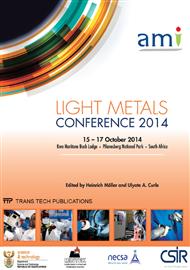p.81
p.90
p.96
p.103
p.112
p.120
p.126
p.133
p.143
The Influence of Plate Gap on the Fatigue Properties of Friction Stir Welded AA5182-H111 and a Comparison with MIG Welding
Abstract:
In industrial applications tight control during weld set-up equates to increased manufacturing cost. Solid state welding processes, particularly friction sir welding, do not generally make use of filler metals and hence a weld gap will have an influence on joint quality. In the current study the influence of a weld gap of 20% of the plate thickness (i.e. 1mm) in friction stir welded (FSW) joints was compared dynamically to welds made without a gap. These results were benchmarked against samples joined through MIG welding, a widely used method to join aluminium plates in industry. Tests revealed that the introduction of a 1mm gap caused a steeper slope of the stress-life curve of the friction stir welded joints when compared to flaw free welds made without a weld gap. Crack initiation in the 1mm gap FSW samples occurred at the advancing side weld edge where the tool shoulder interacts with the material, while the flaw free ‘zero gap’ welds failed in the parent material from the marks induced during oxide removal. Intermittent root flaws were, however, present in the welds made without a weld gap which decreased the life of the samples as the area of the flaw was increased. MIG welded samples always failed from the weld toe and the fatigue life of these samples were considerably lower than that of the 1mm gap friction stir welded samples. In the friction stir welded samples containing root flaws, a flaw across the entire sample width was required to reduce the life of the friction stir welds to that reached by the MIG welded samples.
Info:
Periodical:
Pages:
112-119
Citation:
Online since:
October 2014
Authors:
Keywords:
Price:
Сopyright:
© 2014 Trans Tech Publications Ltd. All Rights Reserved
Share:
Citation:


